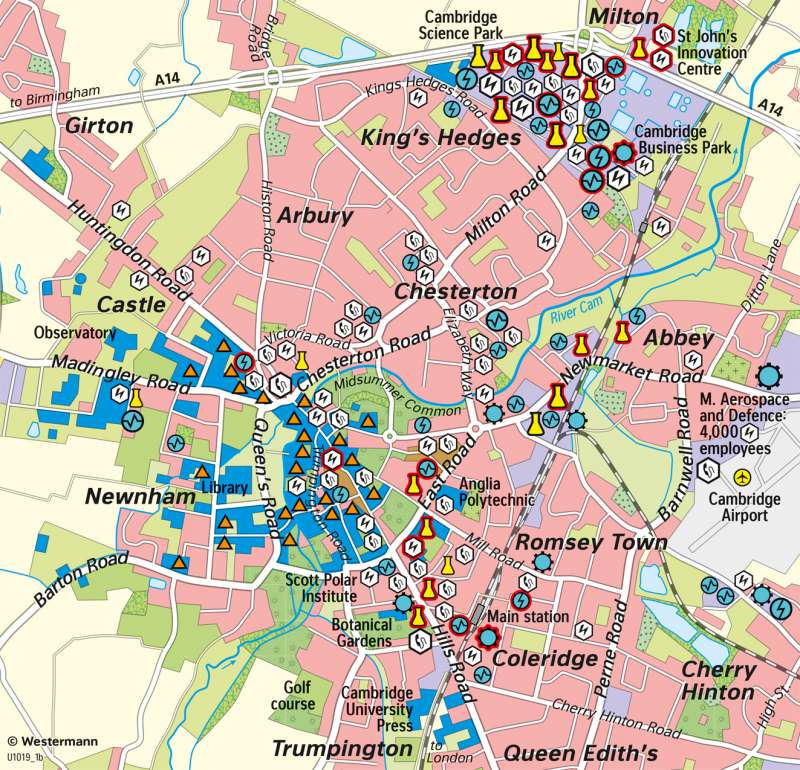Cambridge (England) - Urban development of a university town
Industrial Age
978-3-14-100890-6 | Page 85 | Ill. 3

Overview
The map shows the distribution of high-tech companies in the English university city of Cambridge. The city, situated to the north-east of London, forms the heart of the "Cambridge Cluster", an accumulation of over 800 high-tech and high-tech-oriented companies in the region.
From a sole University town to a high-tech cluster
In comparison to other regions of England, until the 1970s the Cambridge region had no significant number of industrial or technological companies. The economic development of the city and its environs was of little importance.
The development of the cluster was only made possible by the provision of commercial sites and capital for high-tech companies. The first commercial estate, the Cambridge Science Park, was established in 1970 by Trinity College in the north of the city. The St. John's Innovations Centre was completed in 1987, offering a flexible space for smaller companies.
These were followed by the establishment of numerous further technology centres and parks. Most of these were located on sites that had belonged to the university since the 15th century, but which could only be used for commercial purposes after a relaxation in the planning regulations in the 1970s.
The unusually high levels of both research and company formations attracted investors to jointly fund the often capital-intensive business models. The availability of capital developed into a second decisive growth factor. In 2004, nearly ten percent of the venture capital invested in Europe flowed into the companies in the "Cambridge Cluster".
The structure of Cambridge today
Approximately 130,000 people live in Cambridge today, 25,000 of whom are registered as students at the university. A further 12,000 people are employed directly by the university or in one of its various facilities. In the meantime, due to the high-tech boom in the last few years, more than 500 companies have settled in Cambridge. The majority of these are located to the north of the city in the Cambridge Science Park and the technology centres and smaller technology parks adjoining it, such as the St. John's Innovations Centre or the Cambridge Business Park.
In the framework of smaller, local development measures, large building complexes have been erected to accommodate companies, such as St. Andrew's House in Chesterton to the south. Further complexes are located in East Road and in the area around the main railway station. The region now contains the largest number of technology parks and centres in Great Britain.
More than 130 companies are based in the Cambridge Science Park alone, with more than 7,000 employees. Numerous smaller companies, departments of large international companies have also become established there, for example Amgen, Bayer, and Huawei.
Some of the Cambridge-based firms have already developed into international businesses, while others are moving in the same direction.
The structure of Cambridge today
Approximately 130,000 people live in Cambridge today, 25,000 of whom are registered as students at the university. A further 12,000 people are employed directly by the university or in one of its various facilities. In the meantime, due to the high-tech boom in the last few years, more than 500 companies have settled in Cambridge. The majority of these are located to the north of the city in the Cambridge Science Park and the technology centres and smaller technology parks adjoining it, such as the St. John's Innovations Centre or the Cambridge Business Park.
In the framework of smaller, local development measures, large building complexes have been erected to accommodate companies, such as St. Andrew's House in Chesterton to the south. Further complexes are located in East Road and in the area around the main railway station. The region now contains the largest number of technology parks and centres in Great Britain.
More than 130 companies are based in the Cambridge Science Park alone, with more than 7,000 employees. Numerous smaller companies, departments of large international companies have also become established there, for example Amgen, Bayer, and Huawei.
Some of the Cambridge-based firms have already developed into international businesses, while others are moving in the same direction.




